
The Mission Inn, now known as The Mission Inn Hotel & Spa, is a historic landmark hotel in downtown Riverside, California. Although a composite of many architectural styles, it is generally considered the largest Mission Revival Style building in the United States. Mission Inn Hotel & Spa is a member of Historic Hotels of America, the official program of the National Trust for Historic Preservation.

The Leland Stanford Mansion, often known simply as the Stanford Mansion, is a historic mansion and California State Park in Sacramento, California, which serves as the official reception center for the Californian government and as one of the official workplaces of the Governor of California.
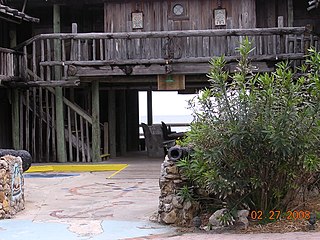
The Driftwood Inn and Restaurant is a historic site in Vero Beach, Florida. It is located at 3150 Ocean Drive. On August 6, 1994, it was added to the U.S. National Register of Historic Places. The Driftwood Inn was opened in 1937, conceived and constructed by local Vero Beach eccentric and businessman Waldo E. Sexton. The hotel and resort were continually expanded throughout the years, and the property is now a partial interval ownership/timeshare along with being a traditional hotel.

The Brandywine School was a style of illustration—as well as an artists colony in Wilmington, Delaware and in Chadds Ford, Pennsylvania, near the Brandywine River—both founded by artist Howard Pyle (1853–1911) at the end of the 19th century. The works produced there were widely published in adventure novels, magazines, and romances in the early 20th century. Pyle’s teachings would influence such notable illustrators as N.C. Wyeth, Maxfield Parrish, and Norman Rockwell. Pyle himself would come to be known as the "Father of American Illustration." Many works related to the Brandywine School may be seen at the Brandywine River Museum of Art, in Chadds Ford.

Riverside Hotel is a former hotel and casino located in Downtown Reno, Nevada, that sits on the exact location where Reno began in 1859. The building now houses apartments and studios for artists and is listed on the National Register of Historic Places.

The Cushing Hotel is a historic hotel in Afton, Minnesota, United States, established in 1867 to cater to railroad workers, lumbermen, and travelers. The hotel was listed on the National Register of Historic Places in 1985 for having local significance in the theme of commerce. It was nominated for exemplifying the commercial lodging common to mid-19th-century river towns. It remains in business as the Afton House Inn.
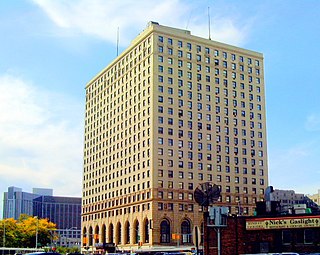
The Detroit-Leland Hotel is a historic hotel located at 400 Bagley Street in Downtown Detroit, Michigan. It is the oldest continuously operating hotel in downtown Detroit, and was listed on the National Register of Historic Places in 2005. The ballroom of the Detroit-Leland has hosted a nightclub, the City Club, since 1983. The hotel is now named The Leland and no longer rents to overnight guests.

The Landmark Inn State Historic Site is a historic inn in Castroville, Texas, United States. It serves the general public as both a state historic site and a bed & breakfast with eight overnight rooms.

Leland Castle is a building in New Rochelle, New York. It was constructed during the years in 1855 - 1859 in the Gothic Revival style, and was the country residence of Simeon Leland, a wealthy New York City hotel proprietor. Leland began to assemble an estate as early as 1848, and in 1855, began the erection of this palatial 60-room mansion. The home was designed by New York City architect William Thomas Beers. A north and south wing were added to the castle in 1899 and 1902 respectively.

The Jacob Sloat House, originally called Harmony Hall, is located on Liberty Rock Road in Sloatsburg, New York, United States. Built in the late 1840s, it is a wooden house that shows the transition from the waning Greek Revival style to the newer Picturesque and Italianate modes.

The Historic Anderson House Hotel is a hotel and event venue in Wabasha, Minnesota, United States. The hotel opened in 1856 and was Minnesota's oldest continuously operating bed and breakfast inn west of the Mississippi River. Most of the furniture dates back to 1856 as well. The building was expanded in 1887. It was listed on the National Register of Historic Places as the Hurd House–Anderson Hotel in 1978 for having local significance in the theme of commerce. It was nominated for being a prominent and long-operating business originating in the years of Wabasha's rapid growth as a river and rail transportation hub. In 1982 it was also listed as a contributing property to the Wabasha Commercial Historic District.
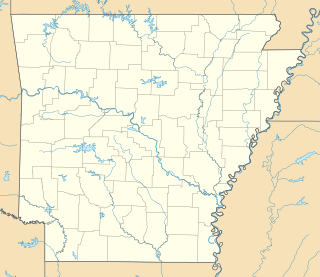
The University of Arkansas Campus Historic District is a historic district that was listed on the National Register of Historic Places on September 23, 2009. The district covers the historic core of the University of Arkansas campus, including 25 buildings.

The Town Farms Inn is a historic poor farm on Silver Street at River Road in Middletown, Connecticut. It was listed on the National Register of Historic Places in 1979. The poor farm provided employment and food for indigent people.
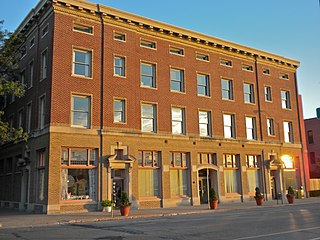
The Northwestern Hotel is an historic building located in the East Village of Des Moines, Iowa, United States. It was listed on the National Register of Historic Places in 1984.

The Peacock Inn is a historic restaurant and inn in Princeton, New Jersey. The building itself dates to the 18th century and was originally located at the corner of Nassau Street and University Place. During the American Revolution it was the home of Jonathan Deare, and played host to members of the Continental Congress when they met in nearby Nassau Hall. It was moved to its current location in 1875 by famed archaeologist and Olympic athlete William Libbey. Joseph and Helen O'Conner purchased the property in 1911 and opened the Peacock Inn, naming it after an inn in Derbyshire, England. The Inn has 16 guest rooms but is most known for its restaurant, consistently rated one of the finest in the state.

Coral Gables is a historic restaurant and resort located at 220 Water Street in Saugatuck, Michigan. It was listed on the National Register of Historic Places in 2009.

S. Walker's Hotel, also known as the Brick Walker Tavern, is a former hotel/tavern located at 11705 US-12 in Cambridge Township, Michigan. It was listed on the National Register of Historic Places in 2007. The hotel is notable for its brick exterior and three-story height - most other surviving early brick tavern/hotel buildings in Michigan are two-story frame structures. The building is currently operated as an event space known as the "Brick Walker Tavern."

The St. Clair Inn is a hotel located at 500 North Riverside Avenue in St. Clair, Michigan. It was listed on the National Register of Historic Places in 1995.
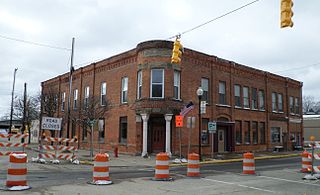
The Hotel Columbia is a former hotel building located at 194 East Huron Avenue in Vassar, Michigan. It was listed on the National Register of Historic Places in 1992. The building now houses a restaurant, the Riverside Grill.
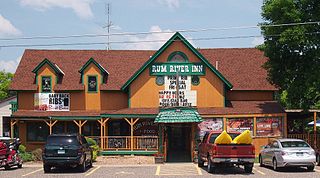
The Riverside Hotel is a historic former hotel in St. Francis, Minnesota, United States. It was originally built around 1860 as a residence, then expanded into a hotel beginning in 1891. This period spanned the heyday of the local lumber industry that urbanized present-day Anoka County, Minnesota. The property was listed on the National Register of Historic Places in 1979 for its local significance in the theme of commerce. It was nominated for being the only surviving commercial building dating to St. Francis's settlement as a lumber boomtown, and its association with the Woodbury family that helped found St. Francis and Anoka, Minnesota.























